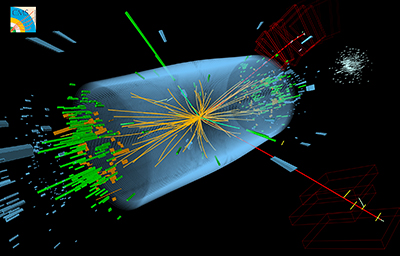 Almost certainly Higgs!
Almost certainly Higgs!
A conference at CERN, the site of the Large Hadron Collider, on the border of Switzerland and France, recently unveiled current and ongoing results of two experiments, each a collaboration of thousands of scientists around the world. The Large Hadron Collider is the world’s largest particle accelerator, capable of smashing particle beams into one another at incredible energies. The CMS and ATLAS experiments watched the results, and they’ve both found something.
In 1964, three groups of scientists, trying to solve a problem in particle physics involving the theoretical generation of massless particles that are observed to have mass, proposed a mechanism by which particles gain mass. The proposal required another elementary particle, of a type called a boson. It would be very massive. One of those papers was written by a Scottish physicist by the name of Peter Higgs. Since then, the field, mechanism, and boson has been named for him. And so we have the Higgs boson. Because of its mass, and thus the high energies needed to observe it, it has been an elusive particle. It is also the last of the particles in what particle physicists call the Standard Model yet to be observed. Finding a Higgs boson is a big deal. Such a discovery would give substantial confirmation to the quite successful Standard Model.
An excellent, and short, video with theoretical physicist John Ellis explaining the Higgs mechanism and Higgs boson in non-technical terms is available at the CERN website here. It’s well worth viewing for a better understanding of what all this is about. Other links scattered through the post also provide more information.
At the CERN conference today (July 4, 2012), spokespeople for the CMS and ATLAS experiments shared their findings to date, sometimes including results of analysis that became available as late as the previous day. What they reported boils down to this: they have observed a new boson consistent with a Higgs-type particle! Over the last year and a half, they have been collecting good data about various ways a Higgs boson could decay, diligently comparing it with background noise and expectations, and so on. What they reported today was that, when the data is put together, they have a significant signal (in excess of expected background) indicating a boson at about 125-126 GeV. (GeV is giga-electronvolts. An electronvolt is a unit of energy, which directly relates to mass, used by particle physicists. The giga- prefix, one might recall from its usage in hard drives and computer memory, indicates billions.) The experimental results have reached a milestone referred to as 5σ (five-sigma). This refers to the statistical strength of the signal, 5σ being five standard deviations. In other words, this is a measurement of how likely the signal is real as opposed to some random effect or fluke. A 5σ result means that they are 99.9999+% certain that there is indeed something there, and it is the (perhaps somewhat arbitrary) standard for a discovery in such matters.
And, so, these teams announced that they have discovered a boson. This is a big deal in the world of physics.
There is still work to be done, of course. They would like to get more data, especially on some of the other ways that a Higgs boson would be expected to decay. They need to probe the properties of this particle. Is it really a Higgs boson (which seems really, very likely) or is it something else not predicted by the Standard Model? Then there are variations of the standard model with variations of possible Higgs bosons, so they will need to do more work to determine what kind of Higgs it may be. In other words, this result isn’t the end of the search, but the beginning of much study and exploration.
Never-the-less, it seems appropriate to say this: The Higgs almost certainly does exist.
Today’s announcements are significant, historic, and spectacular news.
Please allow me to also indulge on a personal note: One of the multitude of scientists who have worked on this project is a fellow physics classmate of mine from St. Olaf College. He works at CERN as part of the CMS collaboration. Congratulations to Greg and all of his colleagues around the world.
Leave a Reply